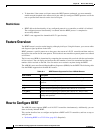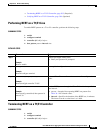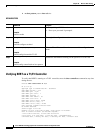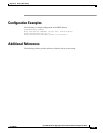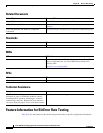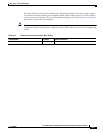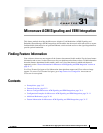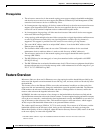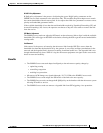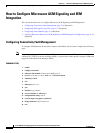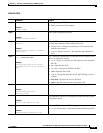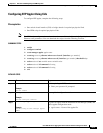
31-2
Cisco ASR 901 Series Aggregation Services Router Software Configuration Guide
OL-23826-09
Chapter 31 Microwave ACM Signaling and EEM Integration
Feature Overview
Prerequisites
• The microwave transceiver in the network topology must support adaptive bandwidth modulation,
and the microwave transceiver must support the Ethernet Connectivity Fault Management (CFM)
extension for microwave devices as defined by Cisco.
• In a heterogeneous ring topology, all devices connected directly to the microwave transceiver must
support signal degradation (SD) functions. Devices not connected directly to the microwave
transceiver can be standard-compliant nodes or enhanced SD-capable nodes.
• In a homogeneous ring topology, all links must be microwave links and all devices must support
microwave SD-based ring protection.
• A ring topology with multiple microwave links can experience a signal degradation condition on one
or more of the microwave links. Only one signal degradation condition per ring instance is
supported. This support is provided on a first-come, first-serve basis, per ring instance.
• The source MAC address must be an unique MAC address. It can be the MAC address of the
Ethernet port or the Bridge.
• The destination MAC address must be set to the CCM multicast address for the associated
maintenance level (a multicast address is used to avoid discovery of MAC addresses).
• The microwave transceiver in the network topology must support bandwidth vendor specific
message (BW-VSM
1
).
• The BW-VSM may be sent untagged, or it may be transmitted with a configurable valid IEEE
802.1Q VLAN tag.
• The BW-VSM must be associated with maintenance level 0. The microwave equipment should allow
the network operator to associate the message with a valid maintenance level in the range 0 to 7 per
ITU-T Y.1731 / IEEE 802.1ag-2007.
Feature Overview
Microwave links are often used in Ethernet access ring topologies and the bandwidth provided by the
microwave link depends on environmental factors like fog, rain, and snow, which can drastically affect
the bandwidth.
This feature relies on the Ethernet CFM to assess the environmental conditions on either end of the
microwave link and automatically change the modulation to provide optimal bandwidth. The Ethernet
CFM monitors the microwave link bandwidth, and when a link degradation is detected, notifies the
router to take action on the degraded microwave link.
In IP/MPLS, the nodes are unaware of any changes to the bandwidth on the microwave link and the
Gigabit Ethernet connection to the nodes remain constant. To ensure optimal routing and traffic transport
across the access network, a mechanism has been implemented to notify the IP/MPLS access nodes of
any ACM events on the microwave links. This enables microwave radio transceivers, which support
ACM, to report link bandwidth information to an upstream Ethernet switch.
The vendor-specific message (VSM) in Y.1731 is used to notify Cisco routers of ACM events, and the
bandwidth available on the microwave link. Acting on this information, the node can change the
Hierarchical Quality of Service (H-QoS), adjust the Interior Gateway Protocol (IGP) metric of the link
to the new capacity or remove the degraded link.
1. The BW-VSM is defined to report the available bandwidth information from the microwave radio to the
Ethernet switch.



